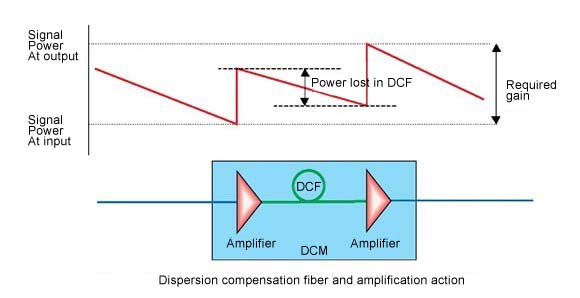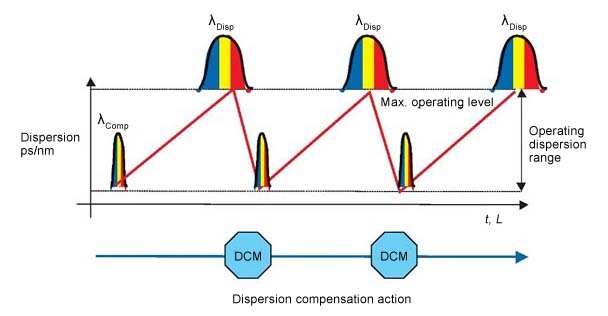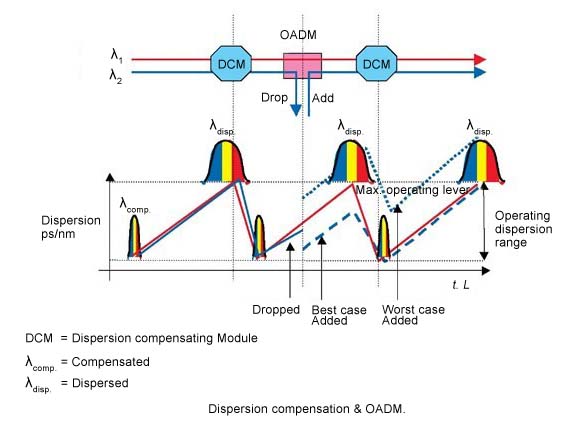FS-DCM-90 Dispersion Compensation Module
The Fiberinthebox Dispersion Compensation Module (FSDCM) provides negative dispersion for dense wavelength division multiplexing (DWDM) transmission systems and can be used to compensate dispersion on standard single-mode optical fiber (SMF) across the entire C-Band. The small form factor (SFF) of the FSDCM enables extended DWDM transmission in a very small footprint. When combined with Fiberinthebox transponders and amplifiers, the WRDCM provides a simple, reliable, and cost-effective DWDM transpo solution.
The FSDCM-20, -30, and -40 are specifically targeted for link pre-compensation and may be used before a booster amplifier. The FSDCM-20, -30, -40, -50, and -60 may be used for inline compensation or for post-preamp applications. The WRDCM can suppo single- or multi-channel (C-Band) applications at both 2.5 and 10 G line rates.
FS DCM can compensate the dispersion with optimized residual dispersion for standard single-mode fiber (G.652) in the C-band.The modules based on mature and reliable optical fiber technology with excellent performance for optical transmission system. DCM modules are available with any dispersion values from -10 to -2100 ps/nm at 1550nm wavelength. We Fiberinthebox stock a diverse selection of DCM, range from 10KM to 120KM.
The FSDCM-20, -30, and -40 are specifically targeted for link pre-compensation and may be used before a booster amplifier. The FSDCM-20, -30, -40, -50, and -60 may be used for inline compensation or for post-preamp applications. The WRDCM can suppo single- or multi-channel (C-Band) applications at both 2.5 and 10 G line rates.
FS DCM can compensate the dispersion with optimized residual dispersion for standard single-mode fiber (G.652) in the C-band.The modules based on mature and reliable optical fiber technology with excellent performance for optical transmission system. DCM modules are available with any dispersion values from -10 to -2100 ps/nm at 1550nm wavelength. We Fiberinthebox stock a diverse selection of DCM, range from 10KM to 120KM.
Key Features
100% slope compensation of G.652 fiber in C-band (Typical) Low Polarization Mode Dispersion Compensates standard single-mode optical fiber (G.652) Compatible with C-Band DWDM optical channels Low end-to-end inse ion lossVariety of compensation lengths19-inch 1RU rack mountable design
Applications
Typical Application Cases of FS-DCM Series


Compensated for the signal loss from DCF(dispersion compensating fiber) with amplifiers(a 5-km DCF may cause 2.5-dB losses.)

Dispersion compensating modules (DCM) have been engineered that are used in systems and/or in regenerators to help increase the span of fiber.

Optical add-drop multiplexers (OADM) may limit the dispersion. The reason is that the dispersion characteristics of a dropped signal and an added are not the same. This picture illustrates the point for the best and worst cases.
Ordering Information
| Product Code | Description |
| FS-DCM-10 | 10 km Dispersion compensation module |
| FS-DCM-20 | 20 km Dispersion compensation module |
| FS-DCM-30 | 30 km Dispersion compensation module |
| FS-DCM-40 | 40 km Dispersion compensation module |
| FS-DCM-50 | 50 km Dispersion compensation module |
| FS-DCM-60 | 60 km Dispersion compensation module |
| FS-DCM-70 | 70 km Dispersion compensation module |
| FS-DCM-80 | 80 km Dispersion compensation module |
| FS-DCM-90 | 90 km Dispersion compensation module |
| FS-DCM-100 | 100 km Dispersion compensation module |
| FS-DCM-110 | 110 km Dispersion compensation module |
| FS-DCM-120 | 120 km Dispersion compensation module |
Specifications
| Product | DCM-20 | DCM-30 | DCM-40 | DCM-50 | DCM-60 | |
| Optical Characteristics | ||||||
| Insertion Loss (dB)1 | 2.7 | 3.3 | 4.0 | 4.3 | 5.4 | |
| Dispersion ±2% (ps/nm) 2 | –325 | –487 | –650 | –812 | –974 | |
| PMD (ps) | 0.29 | 0.36 | 0.42 | 0.45 | 0.51 | |
| Physical Characteristics | ||||||
| Size (W x H x D) | 25.4 x 223 x 175 mm?1 x 6.89 x 8.8 in) | |||||
| Optical connectors and fiber type (all ports) | LC/PC bulkhead | |||||
| Weight | 0.36 kg(0.76 lb) | |||||
| Environmental Characteristics | ||||||
| Operating ambient temperature | –5°C ~ 55°C | |||||
| Storage temperature | –40°C ~ 85°C | |||||
| Relative humidity(non-condensing) | 5% ~ 95% | |||||













